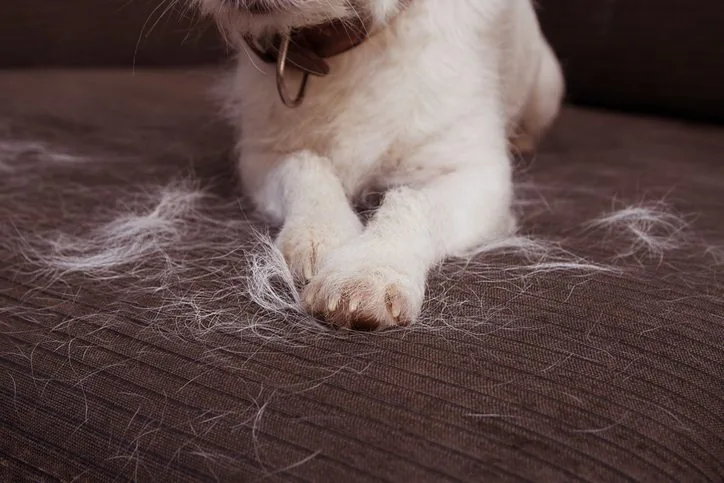Why Do Dogs Shed?
If you have a dog, chances are good you’ve had to deal with her shedding coat a few times per year. But why do dogs shed? What makes some dogs more likely to shed than others, and which factors contribute to more frequent shedding at certain times of the year?
In this article, we’ll answer all these questions and more. You’ll find a quick list of information to help you better understand why your dog may be shedding and what, if anything, you can do to reduce their shedding issues. Read on to find out more!

Double Coated
Double coated dogs are considerably more likely to shed than dogs with any other type of coat. These dogs have an outer layer of hair that is harsher and rougher, and a softer interior layer closer to the skin. This type of coat is most commonly found in breeds that are designed to withstand colder temperatures and climates.
These types of dogs require a lot of grooming care and maintenance. It is always important to brush these dogs very frequently, as brushing can help loosen and remove hairs before they are shed naturally.
Long Haired
Additionally, although double coated dogs are the most likely type to shed, long haired dogs may also have more of a shedding problem than others. Since their hair is longer, it’s heavier and thus more likely to fall out easily than shorter hair. You are also more likely to notice long hairs being shed than very short, fine hairs.
If you have a long-haired dog, it’s important to keep up with their health, wellness, and grooming needs to reduce their shedding.
Seasonal Shedding
Dogs who are prone to shedding are likely to experience seasonal shedding as well. Seasonal shedding is when dogs lose more of their coats at hotter times of the year. This tends to happen twice per year: once when the weather outside turns hot during the summer, and once when you begin running your heater inside during the winter.
Double coated dogs, however, have seasonal sheds all year round. This is because their coats are constantly growing thicker to combat cold temperatures and then dropping their hair when it gets slightly warmer outside. These dogs are likely to be the most significant shedders throughout the year for this reason.
Lack of Grooming
If you never groom your dog or take them to the groomer to have this done professionally, then you’re likely to experience more frequent and more significant shedding. By keeping up with regular grooming requirements for your pet, you can ensure that she sheds less frequently and less abundantly, too.
Even dogs with very short coats need to be brushed every few days to remove loose hair. Dogs with any coat type should be brushed with the appropriate type of brush for their needs and should be given a bath at least once per month as well. Bathing and drying your dog can further remove loose hairs before they become a shedding issue.
Illness
Some types of illness may contribute to hair loss in your dog. Certain types of cancer, hypothyroidism, Cushing’s disease, and several types of skin conditions all have the potential to cause a dog to lose their hair quickly.
If your dog’s shedding has become significant in a short amount of time, or if you’ve noticed any major changes in the pattern of their shedding without other explanations, illness could be the cause. Talk to your veterinarian if you suspect your dog is shedding due to illness.
Food Allergy
Although you may not realize it, food allergy is one of the most common causes of significant shedding and other coat health issues in dogs. If your dog is allergic to or intolerant of any ingredient in her regular food blend, they may lose their coat more frequently. They may also have a dull, drab coat and frequent issues with dandruff as well.
Try changing your dog to a healthier food blend with a different protein source and fewer filler ingredients. This way, you can see if their hair loss and other coat issues clear up before rushing them off to the vet.
Contact Warrick Veterinary Clinic for More Information on Why Dogs Shed
As you can see, there are many potential causes of shedding in dogs, and it’s up to you and your vet to determine what’s going on with your pet. If your dog comes from a breed that is known for its shedding, then you may not be able to do anything to change this; however, if their shedding is related to a medical condition, you may be able to make some changes to improve the problem.
Additionally, make sure you keep up with your dog’s grooming needs to reduce their shedding as well. Brush them frequently and give them baths at least once a month for best results. For more information, contact Warrick Veterinary Clinic by calling (812) 897-4855. Our highly trained veterinarians are dedicated to providing personalized and compassionate care.
